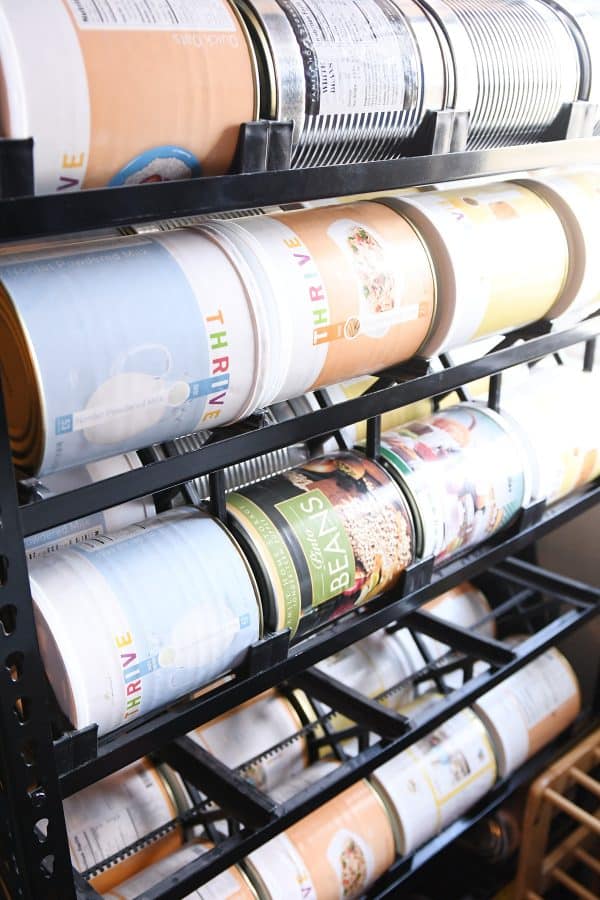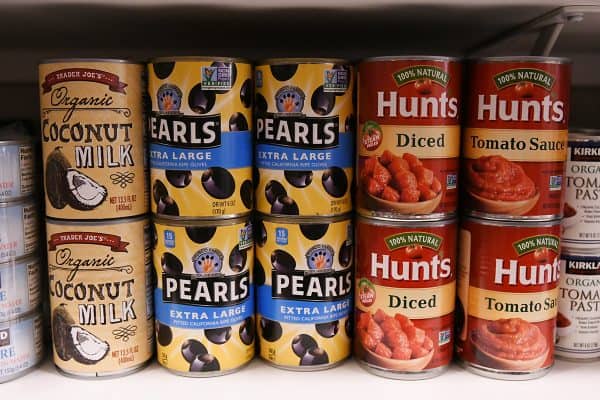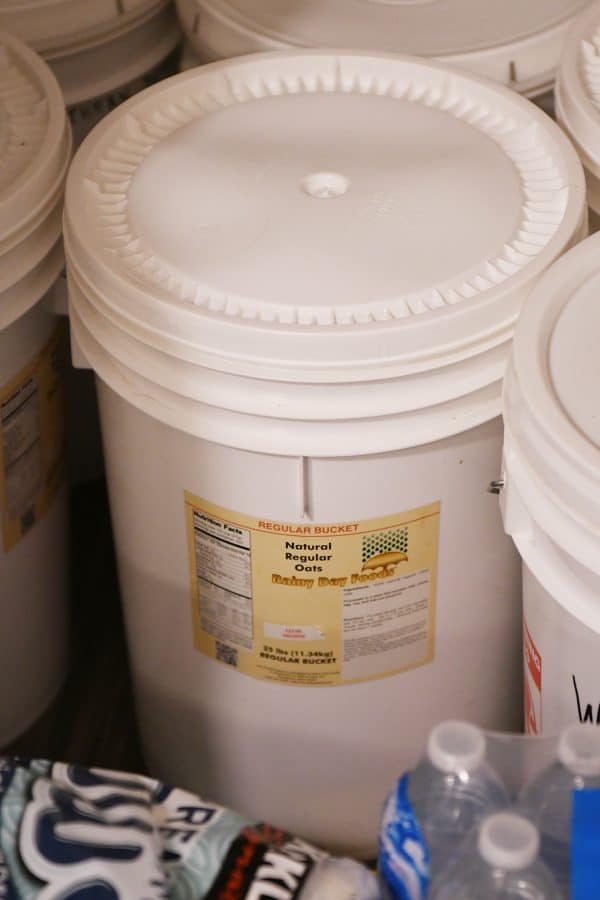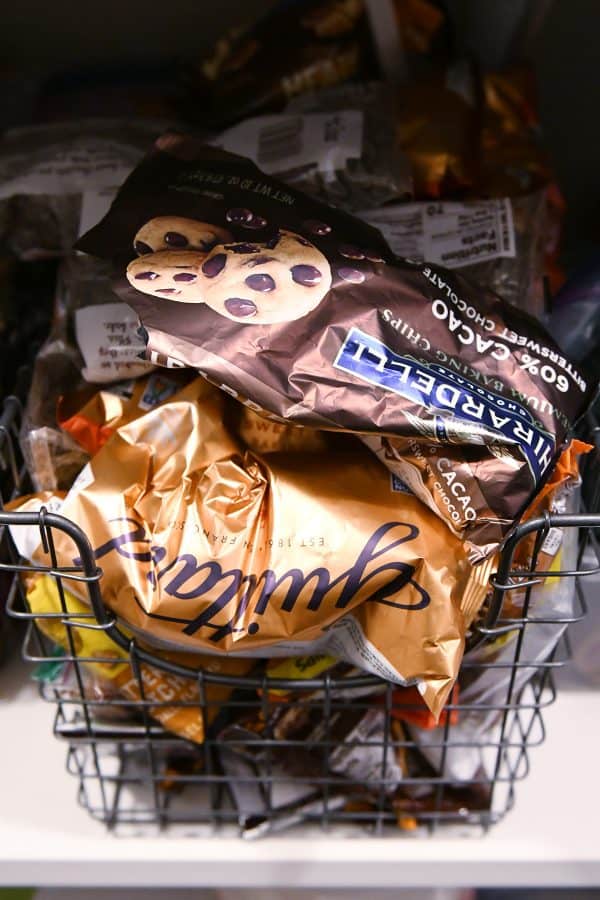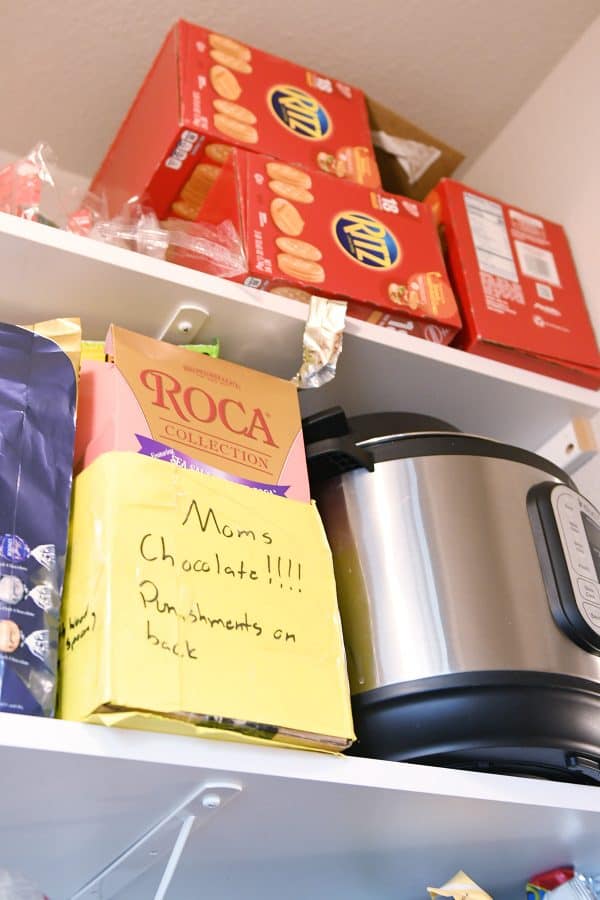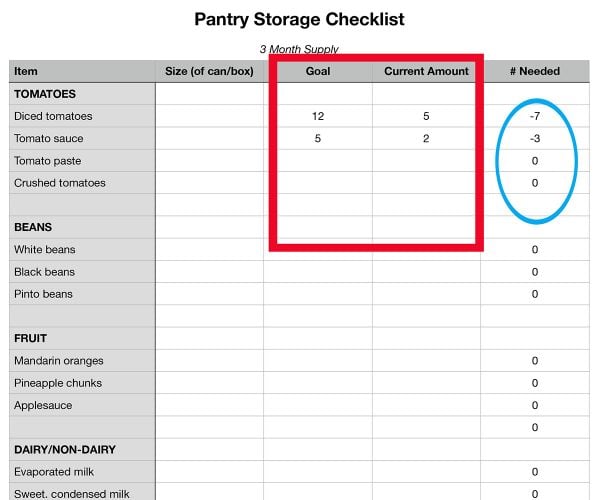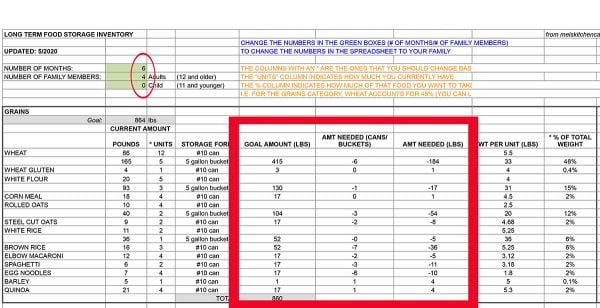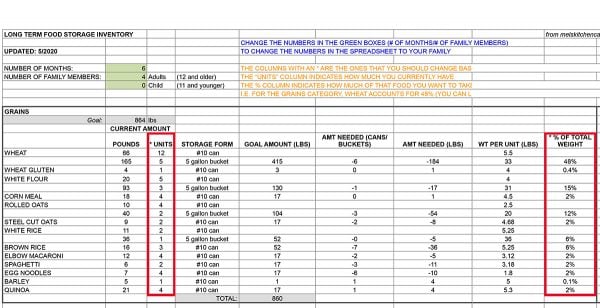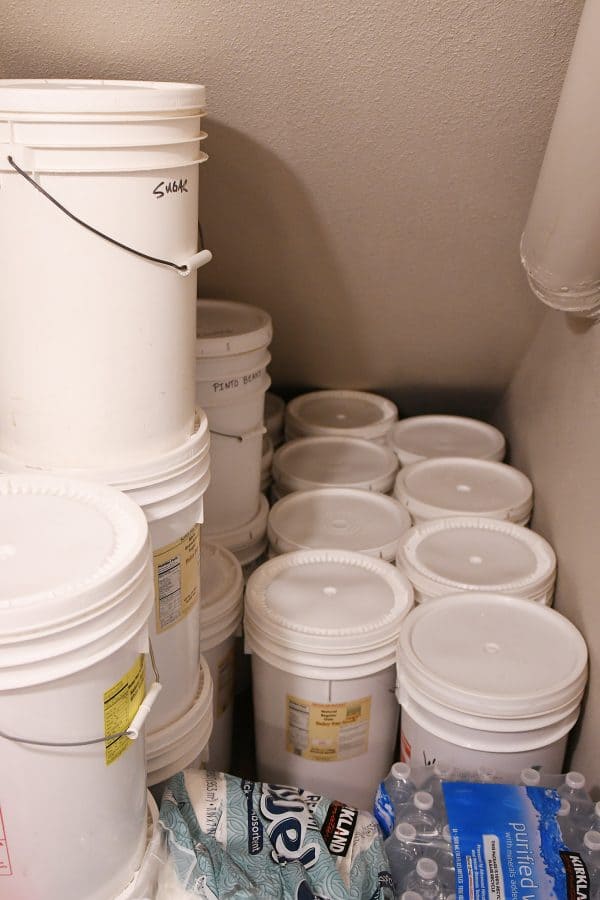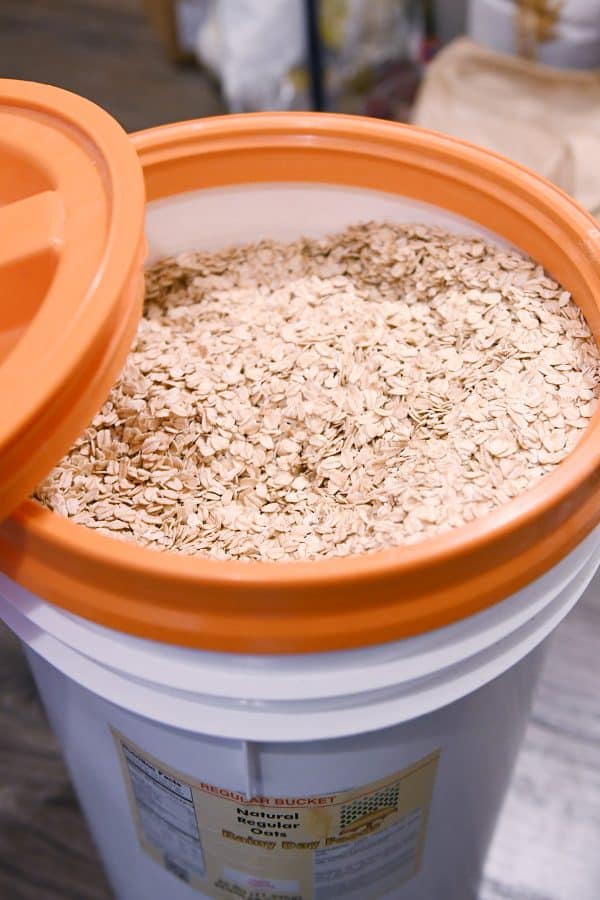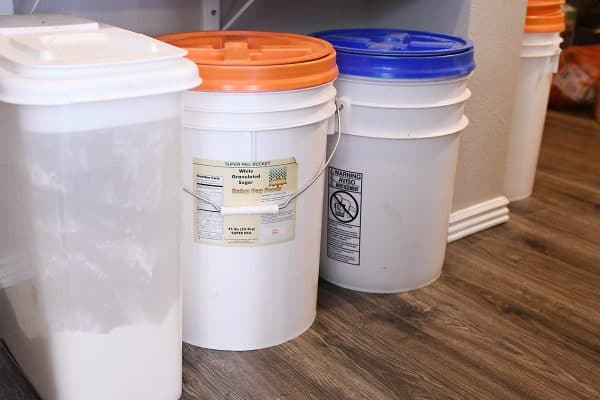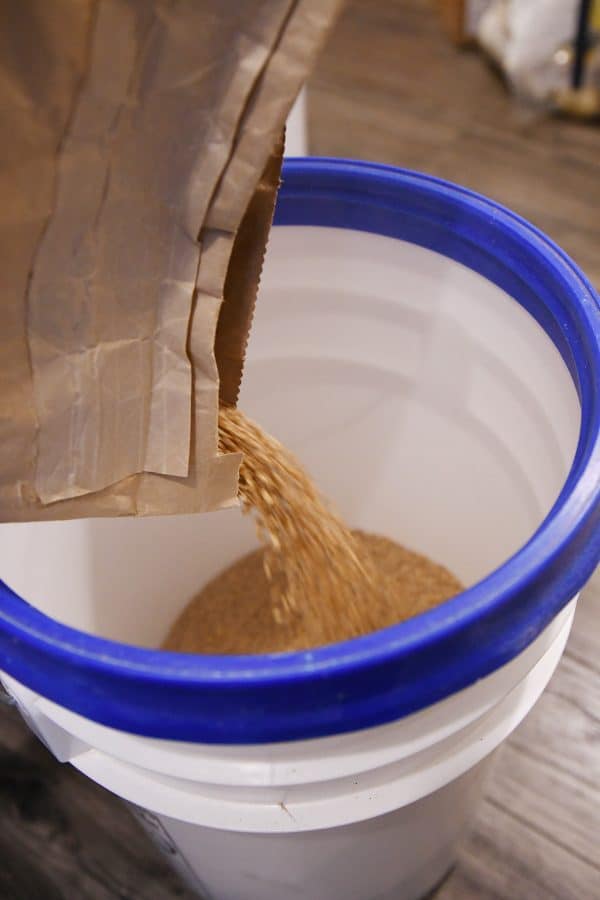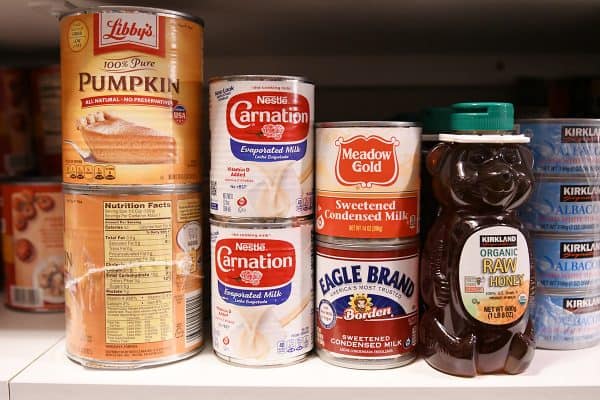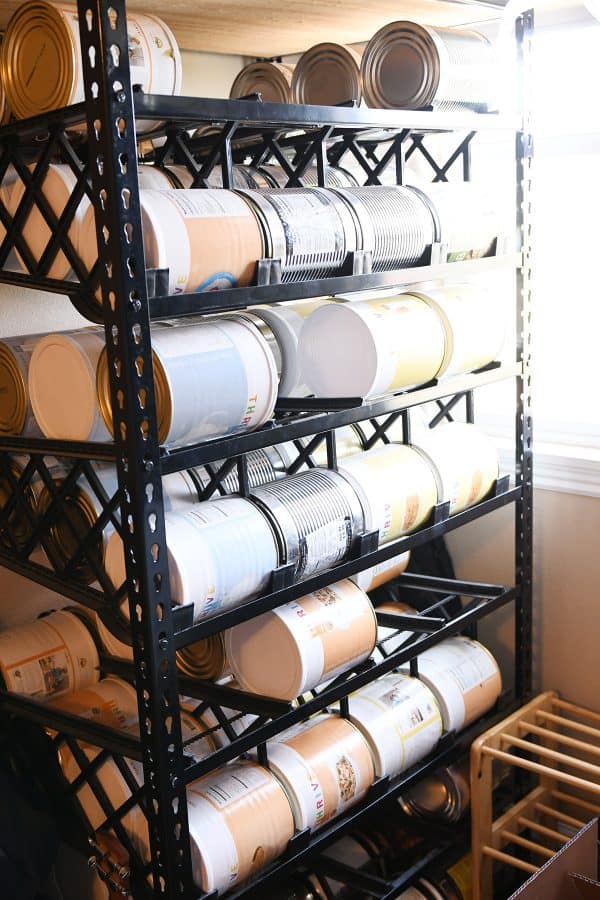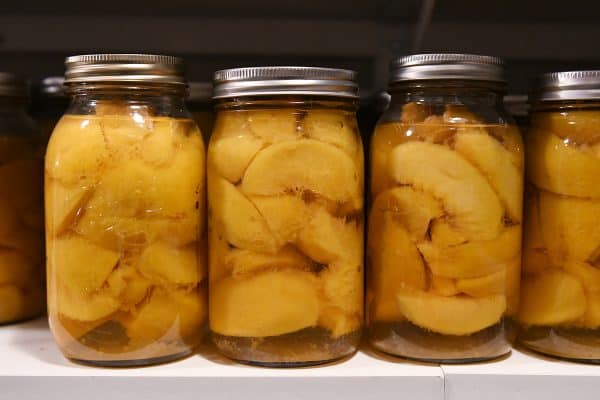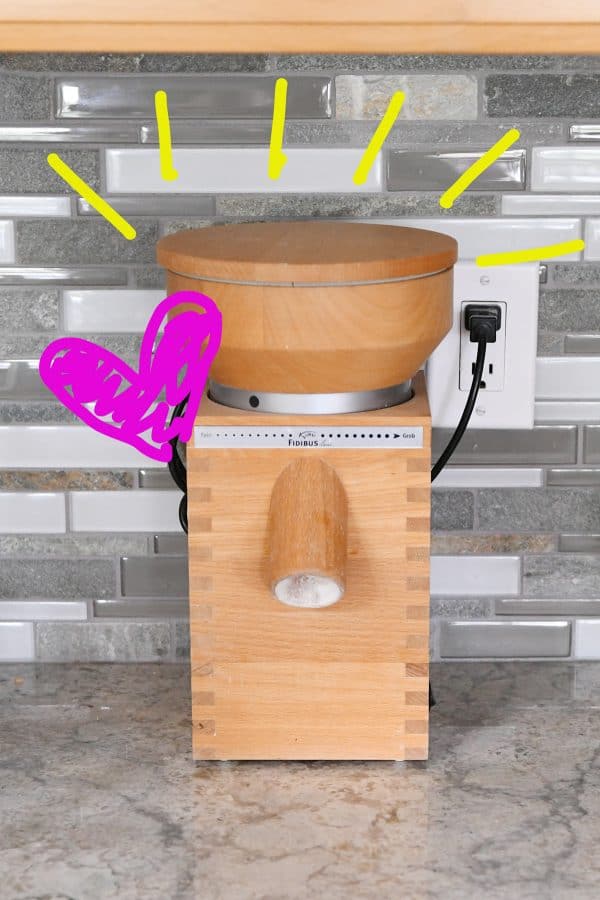Food Storage 101! Spreadsheets, sources and tons of other tips to make planning and building up long term and short term food storage easy, affordable, and doable.
The words “food storage” can feel overwhelming, totally foreign, straight up boring, no-idea-where-to-start…or if you’re like me…totally fun. Haha. Yes, I’m a food storage nerd!
And today, I’m excited to (finally!) share with you all of the tips and resources and spreadsheets (!!) I’ve utilized over the last almost 20 years to create a food storage plan for my family that actually works. Plus, it’s easy, affordable, and totally doable.
Why food storage?
After this post a few months ago and hundreds and hundreds of comments and emails and questions later, it’s clear that a lot of us have food storage (and other preparedness principles on our minds, especially considering the circumstances we’ve all lived through the last few months).
Beth left this comment on that post: Not being of the Mormon faith, I always just assumed that the storage of extra food was a religious thing but a quick google search thing tells me it is just based on prudent living. I would be interested in the details of how you manage to keep stuff current, etc. Those of us with small basement pantries often find them out of date and useless. Any further info would be appreciated! Stay safe…..and healthy.
Beth is right! Building up a doable food storage in your home is exactly that: prudent living. It may be a pandemic, job loss, natural disaster, desire to simplify a grocery budget…or a variety of other reasons that would benefit from an intentionally built food supply.
5 foundational principles for building your food storage
- There is not a one size fits all approach to food storage.
- Don’t store (or even think about storing) food that you or your family doesn’t like or doesn’t eat. Just don’t do it, even if 1,000 sources online tell you that you should. It’s a waste of time and money. (Lima beans, I’m looking at you.)
- Don’t go to extremes or go into debt to build a food supply or a Pinterest-worthy food storage (is there such a thing)?
- If you are starting from scratch, start with a one day supply (yes, one day!) and build up from there gradually. When you know how much you need for one day, build up to planning and buying a one week supply and so on.
- Abandon the idea of a stockpile of food hidden in the basement that can last 30 years untouched and move toward a LIVING food storage. Sounds weird, but it works, and I’ll show you how a) this changed my life and b) how I implement it.
Let me reiterate
I can’t say this enough: what works for me MAY NOT WORK FOR YOU. The ideas and resources and spreadsheets I’m sharing in this post are tailored to my family and what works for us.
Take the ideas, or just bits and pieces of them, tweak them for YOU, and above all, please don’t get overwhelmed.
I’m sharing a lot of information. It might be easy to get stressed or even irritated – that’s the opposite of my purpose today! I really do just want to help.
What is a living food storage?
I grew up with parents who had a lot of food storage. In boxes. Cans. Buckets. It was all tucked away in the dark recesses of cellars and closets. And I literally never saw any of those boxes, cans or buckets get opened.
I legit think my mom threw it all away a couple years ago because it was long expired and never used (after it had been dutifully gathered and stored and moved from house to house – over 20 times and over 40 years!).
When I was first married 18 years ago, I figured I’d channel my parents and eventually start gathering wheat in buckets and powdered milk in cans and stuff it under the bed. Until I realized a) I didn’t have a wheat grinder, b) ew, powdered milk, and c) my husband was like, “heck no, we can’t afford any of that.”
So I did nothing. And quite honestly, I was fine with it. Until five or so years later (2007-ish) when I started getting these internal nudges that I needed to start thinking more about food storage. We were moving a lot. I was having a lot of babies. I had stopped working outside of the home. And I liked the idea of having food we could use in an emergency or if something happened.
After a lot of research and talking to people and starting to buy and build up our food storage, I realized I wanted a living food storage. Not necessarily a short term food supply and not a long term food supply.
Just an intentionally planned and built food storage that I could use every day and replenish as needed.
Diane left this comment on an earlier post: Food storage doesn’t have to be a huge initial investment like some people think! I’m constantly restocking my pantry. It’s never an all-at-once thing. I watch for sales and that’s when I stock up. Or buy 2-3 items instead of just one (for example, if I’m getting low on soy sauce, I buy a couple extras to store in the pantry). If you have the mentality that you’re saving some for later, you can stock up a little at a time and it doesn’t add a lot of expense. Like you, I’ve learned to store what we eat and eat what we store. I have powdered eggs and milk and there have been multiple times where I started making something assuming I had eggs (or milk) because I always have those things, but realized I was down to my last egg or ran out of milk. The powdered varieties might not be good by themselves, but they work great for cooking!
I couldn’t agree more!
How to start planning a food storage
Plan out your meals for one day (or even better, for one month) and take a good look at what your family eats.
Grains. Dairy. Sweets. Snacks. Fruits and veggies. All of it.
Make a list of the foods and quantities and then…multiply by three months. You can see where I’m going with this. Gradually start building up that 1-month or 3-month supply by picking up 1-2 extra things each time you go to the store. You don’t have to buy it all at once!
Most importantly, do not shove those foods to the back of your pantry or cupboards! Rotate through them so the foods stay fresh, and replenish as needed.
And do not, whatever you do, forget to include the chocolate chips. (Yes, that is an open package of Ghirardelli 60% bittersweet chocolate chips on top, because, hello, coping skills, and also, they are the best things in the history of ever.)
As you start small and then build as budget allows, you’ll be able to see what size packages you need to buy (based on how fast you eat through a box or can of something). Eventually as you build out more months of food storage, you may decide to enhance your pantry storage with a few larger buckets of staple ingredients (I’ll show you how I use those as part of my living food storage below).
Food Storage Tracking Sheet
This might seem overkill to some people, but I keep a food storage tracking sheet close to my pantry (I used to hang it on a clipboard with a pen inside the pantry until it got knocked down too many times by anxious hands sneakily grabbing Oreos without me noticing).
It’s not complicated. It’s a blank table. When I open up a new package or ingredient (anything from a bag of quinoa to a new bottle of BBQ sauce), I quickly write it down on the tracking list. I put a check when it’s gone (my mind is already used to knowing when an empty package or bottle of something gets thrown away, I go straight to my sheet for that check mark). And then I add it to my next grocery list.
It keeps the system running, and it keeps us in a well-stocked supply for at least three months.
My food storage spreadsheet
Ok, now for the nitty gritty of how I put all this into action.
Disclaimer: I am not a casual food storage lady. I’m a true blue through and through die hard food storage fan. I love it. I believe in it. I use it. And I have a testimony (no really, I do) about how important it is.
You don’t have to be like me. Haha. In fact, don’t be like me! Take all this with a couple grains of salt and make it work for you.
That was my way of gently easing us all toward The Great and Nerdy Food Storage Spreadsheet.
You guys, I admit, this spreadsheet is a little intense, especially for someone who wants a slow and easy approach. It has formulas. It’s taken me years and more hours than I care to admit to put it together (and even more hours to fine tune it to post here).
If you are looking to play around with numbers and amounts and pounds, this spreadsheet is for you.
But guess what?? It’s also a good starting place for someone who wants to take things slow and easy and work into food storage gradually! You don’t have to dive headfirst like a kid free falling into a vat of chocolate pudding. Don’t let the spreadsheet turn you off from food storage as a whole. ?
The main page of this spreadsheet is meant to detail foods that can be stored for a long amount of time – kind of food storage “staples” so to speak. I’ll show you some examples below.
The second sheet on the spreadsheet is for pantry goods. It’s a much simpler spreadsheet that tallies how many of each item you have in your pantry and how much you still might need (after you set a goal amount and what you currently have). If the main page/long term aspect of the spreadsheet stresses you out, START WITH THIS pantry storage checklist.
It’s simple and straightforward.
BOTH SPREADSHEETS are meant to be used on a computer or tablet or device that you can plug in numbers and calculate totals (they haven’t been formatted to print well).
On the main food storage spreadsheet, you can edit the # of months and # of family members in the green rows. When you do, all of the amounts in the following categories will change based on the information you enter:
- Goal amount for each food category in pounds
- Amount you still need to buy/acquire (in two formats: pounds and also in # of cans/buckets/bags or however else you store it)
Additionally, you can (and should!) go into the spreadsheet and tailor the Units and % columns to fit your needs
- Units: is how many of each item you have already – when you edit the number in the units column, it will automatically change the amount in pounds right next to it
- % of Total Weight: Stick with me here!! There are main categories on the spreadsheet like Grains, Legumes, Dairy, etc. Changing the # of months and # of family members changes the total goal amount for each of those main categories. The goal amounts are largely based on this food storage calculator (and you can totally change them!). Within each of the main categories, different food items make up the total. So for instance, in the Grains category, I store: wheat berries, white flour, corn meal, rolled oats, steel cut oats, white rice, brown rice, etc. And based on how much of each of those we use, I assign a % in that last column. We grind a lot of wheat and make a lot of bread, so wheat makes up 48% or so of our grains category. If your family doesn’t have a wheat grinder (or is gluten free!) you’ll want to change that % to zero, or better yet, plug in a food that you DO eat and that you DO want to store.
Did that make sense? Are you still here? Tap, tap, is this thing on????
Play around with it. Change up the numbers. And the foods. And just make it your own. There’s no copyrights or infringements. I’m providing it to you as a resource in case you love spreadsheets as much as I do.
Don’t get overwhelmed at what the spreadsheet screams you need to buy or what you might be lacking! Have fun with it. My advice is to start with a big fat THREE in the # of months box and go from there.
Mel’s Food Storage Spreadsheet – EXCEL (includes both the longterm food storage and the pantry food storage)
Mel’s Food Storage Spreadsheet – NUMBERS (includes both the longterm food storage and the pantry food storage)
How this looks in my real life
As I mentioned at the onset of this post, my food storage is living and breathing and being used all.the.time.
Yes, I have a several buckets of natural rolled oats and granulated sugar and hard white wheat stacked up in one of our Hobbit Holes, but they will all eventually be rotated into the Currently Being Used status.
I try to keep about a 6-9 month supply of these staples, and because I rotate them through when one bucket is empty, they are used up long before they expire.
When I’ve used up a bucket or can, I write it down on my food storage tracking sheet so I can replenish (I usually order or buy these larger staple items once or twice a year – I don’t buy a new bucket or can immediately).
I know it isn’t feasible for everyone to store 5 gallon buckets of food. If not, you can do the same thing with #10 cans or smaller packages.
Because my pantry shelves sit at just the right level, I keep those 5 gallon buckets at the ready by putting on handy twist lids.
Along with the staple ingredients, I try to keep a 3-month supply of canned goods that we eat frequently.
I don’t always religiously track these items on the Pantry Spreadsheet (included with the large and in charge spreadsheet linked above), but you can if you want. I usually just eyeball the emptying spot on the pantry shelf and know that I probably better pick up some diced tomatoes at Costco the next time I’m there.
Again what canned and dry goods you store on your pantry shelves will be absolutely dependent on how you cook, what you eat, and how many people are living in your house.
Space for Food Storage
Finding space for food storage can be tricky! I’m sure many of you don’t even have pantries to speak of – while others may have a pantry + a cold storage + 5 1/2 closets dedicated to food storage.
This is exactly why the amount of food storage you build up and store is 100% completely dependent on your personal circumstances. Do what you can!
If food storage is a priority to you, get creative with where to store food even if it is outside of the kitchen! Over the years (before I hired someone last year to knock out the wall between our kitchen and garage and expand my minuscule pantry), we stored canned goods and other food storage items everywhere from under beds to bedroom closet shelves to under stairs (affectionately called our Hobbit Holes) to in the garage (yes, even though it isn’t always recommended because of the heat).
We have one rolling food storage shelf that sits smack dab in the corner of one of our bedrooms. It’s not classy, but it works.
Food storage Resources
First and foremost, if you’re storing practical, every day foods, your every day grocery store might be the best place to start. Especially if you’re building up a one to three month supply. Look at expiration dates and be thoughtful about how quickly you’ll eat through different foods (and how quickly they’ll expire).
*UPDATED with links included in the comments!*
- The Church of Jesus Christ of Latter-Day Saints Online Store: a great, inexpensive option for the basics stored in #10 cans. Can be purchased online.
- Rainy Day Foods: this is probably my favorite place to stock up. They sell almost all their foods in bags, buckets, super pails, cans, you name it. They also have a great variety of gluten free, non-GMO and natural foods. If you put in group orders, you can get a huge discount on shipping. It kind of changed my life when I realized I could get a few sealed cans of brown sugar (I always run out of this and have opened more cans to save a recipe than I care to admit).
- Emergency Essentials: I’ve ordered a lot of food from here over the years. They have a really good variety of freeze-dried fruits and vegetables, but they also carry the basics.
- Azure Standard: I forgot about these guys when I originally posted this! I used to get a lot from them and then kind of forgot, so thanks for reminding me in the comments! GREAT resource!
- Country Life Natural Foods: this is a new one to me (thanks for mentioning it in the comments!), but it sounds like they offer a lot of quality health foods/natural ingredients at wholesale prices and in bulk, if you need it. Excited to check it out!
- Amazon: good ol’ Amazon. This is where I buy a few favorites like Honeyville Steel Cut Oats and a few other staple ingredients.
- Costco: don’t forget the power of a good bulk foods store, like Costco or Sam’s. This is where I usually stock up on baking soda and baking powder (I dip into the big bag of baking soda and fill a small container for my spice cupboard – we go through it pretty fast just with baking, but I also use baking soda for cleaning and other things, so a big bag makes sense for us – it may not for someone who won’t use it as quickly!)
- Thrive Life: I used to order a lot of freeze-dried fruits and veggies from here, but I have to be honest, I have hardly used them, and I regret some of those impulsive stock-up purchases. Don’t be like me! I think you either have a talent for using freeze dried food in recipes or you don’t. I don’t. We snack on the freeze-dried fruit a lot (and use it for school lunches), so we’re slowly using it up, but I’ve decided to try to store fruits other ways since freeze-dried isn’t really working for me in the long term. This company also used to package other cool ingredients like quinoa and whole wheat pasta, but unfortunately, I think they’ve stopped doing those basics and have gone exclusively to the freeze-dried sector.
- YOU: yes, you can be a great resource for your own food storage. Gardening and canning (or freezing fruits and veggies)! And not to get all becky-home-ecky on you, but canning simple things like peaches or jams and jellies is a great (and fun) way to include fruits and vegetables into your longer term food storage. Just like everything else (I know, I know, I sound like a broken record), we eat through our home canned goods all year and replenish during canning season. And if you think you can only can a gazillion jars at once, read this post on small batch canning.
- Local Resources: farmers, co-ops, and even grocery stores can be great resources for food storage or bulk items. For instance, my local Winco sells 25 pound bags of wheat berries (over by the coffee and peanut butter). I’ve found a few local farmers here in southwest Idaho that sell buckets and bags of wheat, oats, etc. When I lived in Minnesota, there was this amazing Amish granary about an hour away that would sell bags of just about anything you can imagine. Ask around and you might be surprised what you find!
Addressing a few questions + lingering thoughts
- Do I store powdered milk? Well, I have to be honest, other than using it in some pretty fabulous cookies, I kind of gag at the thought of mixing it up and drinking it (I’m sorry, every generation of grandmother I’ve ever had is rolling in their grave right now). Could we do it if we had to? I’m sure we could. But I prefer to store our longer term dairy needs in the form of shelf-stable almond milk (like everything else, we use and rotate through it so it doesn’t expire), freeze-dried yogurt bites (the one freeze-dried food we really, really love), evaporated milk, etc.
- Do I have a recipe book of exclusive “food storage recipes”? No. As I’ve mentioned several times, my life is my food storage and food storage is my life. I’m making all the recipes on my site every day with my food storage staples. That’s how I rotate through them. If we are ever “forced” to rely on our food storage, I don’t want to pull a random book off the shelf and hope the “food storage” recipes work. I’ll use the ingredients and recipes I’ve already been using for years (and tailor them as needed based on emergencies or finances or the current situation).
- Why do I store dry beans? Do I honestly cook with them? You betcha! Thanks to the electric pressure cooker, it is super easy to transition dry beans into cooked beans ready for use. I think I would be fine using them exclusively for these pressure cooker refried beans (soooooo goood – and delicious with pinto, black OR white beans).
- How do I store meat for food storage? This is a good question! We have a freezer full of beef from raising our cows that is kind of our main meat food storage plan; however, I actually don’t hate freeze-dried meat. It seems a little questionable, but it works great in casseroles or skillet recipes. So I also have a couple #10 cans of freeze-dried chicken hanging around, too. Thrive Life and Emergency Essentials sell freeze-dried meat.
- Storing water + other necessities: I won’t go into much detail about this (at least in this post), but storing water is an important component of food storage and emergency preparedness. Even just having a case of bottled water is better than nothing. We don’t have huge barrels of water stored, but I did invest in two amazing little water filters {aff. link} for drinking water. I also try to keep a reserve of medications, band aids, toilet paper (!!), flashlights, batteries, and other necessities outside of food. This could be a whole other post, but I wanted to at least mention the importance here for now.
A few extra resources and links
- Gamma Seal Lids: the twist/Gamma seal lids for 5 gallon buckets can be found online (Amazon – aff link); I’ve also seen them at Home Depot and Winco (a local grocery store)
- 5 gallon buckets: can also be found at places like Home Depot, sometimes Walmart (just double check to make sure they are food grade) or on Amazon (aff. link) or Rainy Day Foods – other people mentioning in the comments to look at places like Tractor Supply, farm implement stores, etc.
- Wheat grinder: I have a series of posts on wheat grinding at home. Here’s a post on different types of wheat grinders and another on different types of wheat. As a quick summary, I almost exclusively use hard white wheat (and lately I’ve started using more Kamut and Einkhorn wheat berries, although they are more expensive than traditional white wheat). Wheat that is less than 3-5 years old (and well sealed) will work a lot better than 30-40 year old wheat (even if it has stayed well sealed). Also, I’ve had this KoMo Fidibus grain mill for a decade; I use it every day and can’t say enough good about it. It’s amazing; I use it mostly to grind wheat, although occasionally I throw rice in there to clean it out.
Financially. Physically. Emotionally. Spiritually.
We don’t know what the future holds. But it’s also exhausting and a waste of time to live in fear.
The antidote to not living in fear? Be prepared.
Food storage doesn’t have to look like #10 cans and big white pails like I have in my house. It doesn’t have to last a year or taste gross. It doesn’t have to be 100% organic. And it absolutely positively can include chocolate chips and fruit snacks.
Food storage is what YOU make it. It works for YOU.
I know this post is lengthy and a bit much, but all I really want is for there to be some tidbit that helps someone out in their food storage journey. And as always, I very much welcome YOUR ideas, thoughts, feedback on everything food storage related.
I LOVE learning from you!
Ok, bye now.

